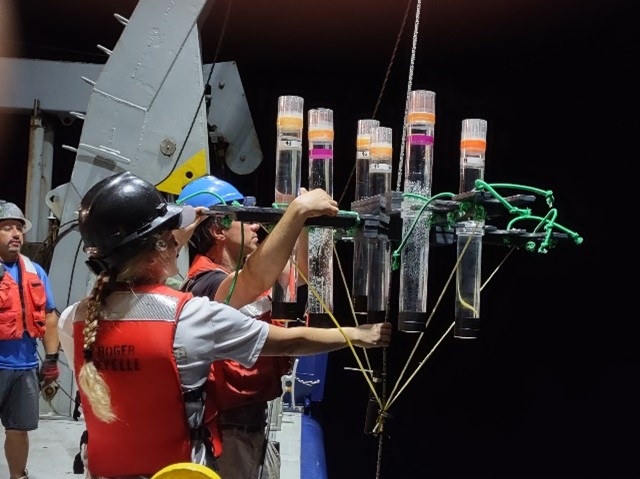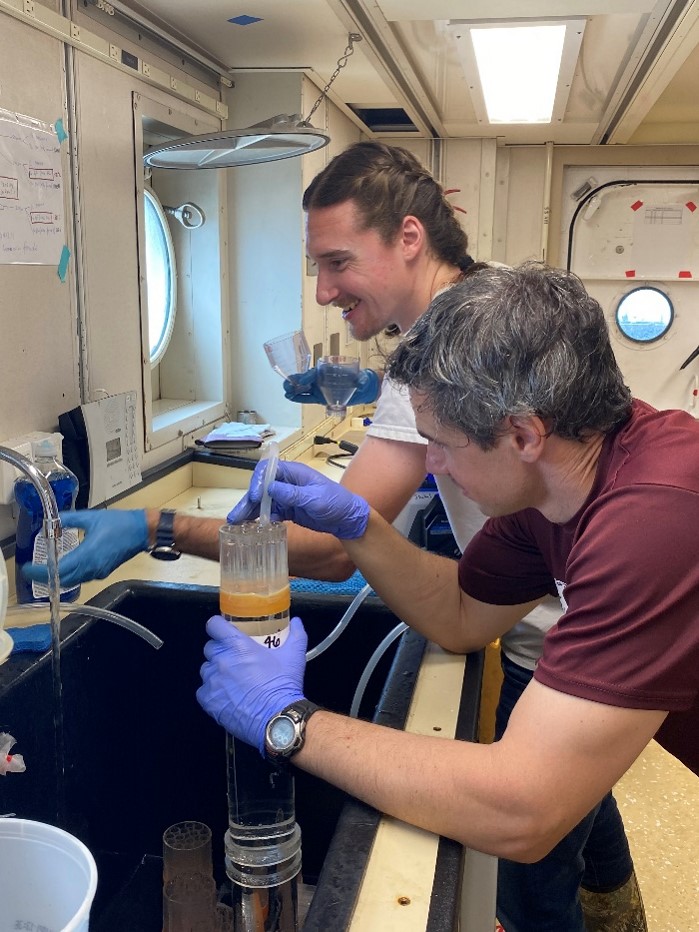Hello! I’m Christian Fender, a 4th year PhD student in the FSU Plankton Ecology Lab. In one of our previous posts, we shared a little about the variety of drifting arrays we’ve deployed over the course of the BLOOFINZ cruise, with special attention to the mighty incubation array and it’s many (very heavy) daily experiments. Today, I’ll be sharing more about the second type of drifter, the sediment trap. As we mentioned last time, our lab’s goal is to understand how the cycling of carbon and nitrogen through the ocean interacts with the organisms through which these crucial elements flow. The sediment trap allows us to look at how sinking particles, sediment if you will, sink out of the surface of the ocean down into the deep. These particles can be anything from the corpses of tiny plankton to the poop of tuna larvae, but they all contain the carbon and other nutrients that fuel life in the seas. In fact, this sinking material is one of the only ways food makes it way to organisms in the deep sea.
 It all begins with the deployment of the sediment trap array, a ~500 meter line with a drogue at the top that pulls the array like a kite along with the water parcel around it. Below this are X-shaped plastic crosses attached at key depths, typically 50, 100, 200, and 440 meters. Onto these frames we attach tubes filled with a hypersaline brine and a small amount of formaldehyde. As particles fall into the tube, the formaldehyde preserves them for the 4-5 days the array is deployed.
It all begins with the deployment of the sediment trap array, a ~500 meter line with a drogue at the top that pulls the array like a kite along with the water parcel around it. Below this are X-shaped plastic crosses attached at key depths, typically 50, 100, 200, and 440 meters. Onto these frames we attach tubes filled with a hypersaline brine and a small amount of formaldehyde. As particles fall into the tube, the formaldehyde preserves them for the 4-5 days the array is deployed.

We also attach a variety of special traps designed for more specific purposes, such as the “Labyrinth of Doom” which contains a series of funnels that make it harder for living plankton to swim into the trap (if they’re still alive, we can hardly consider them sediment). The Labyrinth, rather than formaldehyde, contains a different preservative for the genetic material of the organisms living on these particles so we can learn what type of microbes are breaking them down and releasing the material they contain into the water column as they sink. Similarly, the trace metal team brings their own tubes filled with a metal-free brine so that they can determine the amount of iron and other trace metals in the particles without contamination from the ship. Thanks to our friends from France, we also attach a high speed camera to take pictures of these particles as they fall into a large collection funnel, collectively named the Visu Trap. To hear more about this and the other high tech particle imaging systems employed, make sure to check out Manon Lagot’s post!

Once the array has been brought back on board at the end of a cycle, the real work begins. Our team has only until we reach the next station to process all 50 tubes and then prepare them to be put right back into the water so the next cycle can begin. The first step is to remove all the “swimmers,” or plankton that may have swum into the traps by accident mentioned above. After that, we begin filtering all the material in the tubes into different containers to be processed back on land. To make sure the filters don’t dry out or any other mishaps, we take shifts so that someone is always awake to watch them. This cruise we managed to prepare the new set of traps while filtering the old for maximum efficiency, finishing the whole process in only ~36 hours! A new record! We stay motivated over these many hours of watching water slowly filter with lots of coffee, music (mostly Disney songs), and the promise of a short nap before waking up just in time to deploy the array and begin the cycle all over again!
Tiring as this may sound, I think I speak for my entire group when I say it’s what we live for. We are thrilled to have had the chance to participate in this multinational adventure and look forward to seeing all the wonderful data that will arise from our collective hard work!
